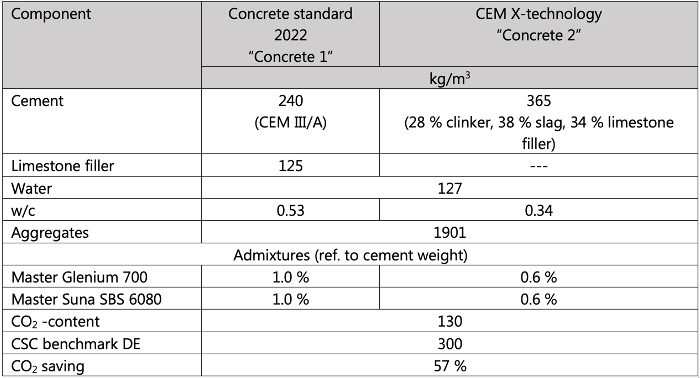CO₂ efficient concrete for a new high-rise building in Berlin
It has been shown that durable concrete with a clinker content of 20%, 30% slag and 50% unburned limestone can be achieved on a lab scale, if the concrete composition (low w/c) is adapted accordingly.

to German concrete standard 2022 and acc. to future CEM X-technology
Based on this research, CO₂-optimised concrete (CEM X) was used on the 32nd and 33rd floors of a new high-rise building in Berlin. Cement with a minimum clinker content of 20% and a main constituent content of up to 50% unburned limestone, could have significantly increased CO₂ efficiency. For the time being these cements will be called CEM X.
The case study[1] shows that a further significant reduction in the clinker content in cements with a high proportion of unburned limestone would be possible if the concretes are composed accordingly. With the same amount of slag, fly ash and calcined clay on a global scale, a much greater volume of sustainable and durable concrete can be produced.
During the construction of the EDGE East Side Berlin, CO₂-optimised concrete was used on the 32nd and 33rd floors. The composition of the concrete C40/50 is given as “Concrete 1” in Table 1. In comparison to the CSC benchmark for a C40/50 in Germany, a CO₂ reduction of 57% and 50% in relation to the average C40/50 was achieved. This is due to the fact that Concrete 1 has an amount of ~ 103 kg Portland cement clinker per cubic meter, whereas the average C40/50 in Germany has a clinker content of 274 kg per cubic metre.
Around 500 m3 of concrete were placed on 12 concreting days. Some of the concrete was pumped at 25 m3/h over a distance of up to 285 m. As the concrete had a low water content the stability against segregation and the sensitivity against temperature was an issue. Therefore, an AI-based, accompanying (online) quality assurance system was installed (2, 3, 4). In the future the combination of CEM III/A and limestone filler will also be produced as a factory-made cement called “CEM X” (see “concrete 2” in Table 1).
[1] Palm, S.; Müller, C.; Proske, T.; Rezvani, M.; Graubner, C. A.: Concrete application of clinker-efficient cements. Advances in Cement Research, Volume 31 Issue 5, 2019, pp. 225-234
[2] Leopold Spenner, lecture given at the VDZ annual conference 2022 in Düsseldorf
[3] https://www.meistertipp.de/aktuelles/news/co2-reduzierter-beton-fuer-berliner-vorzeigebau-edge-east-side
[4] https://www.master-builders-solutions.com/de-de/%C3%BCber-uns/project-references/project-reference-edge-east-side-berlin-tower